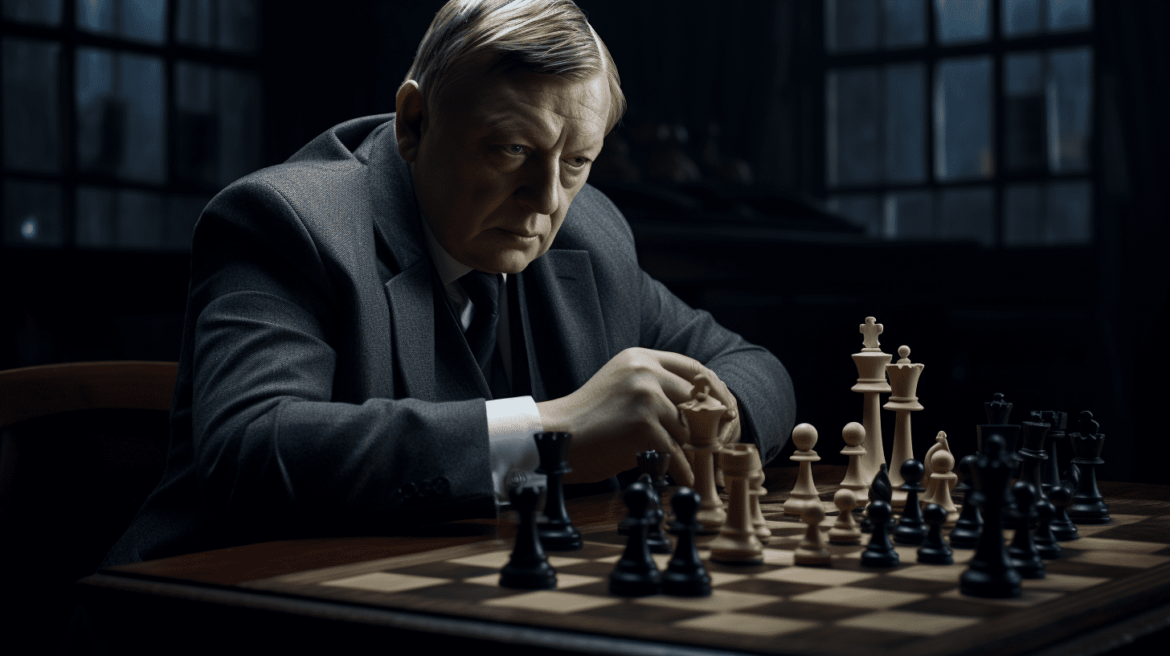In the illustrious annals of chess history, few names resonate as deeply as that of Anatoly Karpov. Born in 1951, this Russian grandmaster dominated the chess world for much of the latter half of the 20th century. To many aficionados of the game, Karpov represents the epitome of positional mastery and intuitive brilliance. His style, often described as quiet yet deeply profound, has both confounded adversaries and captivated enthusiasts for decades. What are the best Karpov chess games?
The 12th World Chess Champion’s rise to the pinnacle of chess was no accident. Armed with a deep understanding of the game’s intricacies and an uncanny ability to capitalize on the minutest of mistakes, Karpov’s play often seemed like a beautifully choreographed dance of pieces. His precision, combined with a serene, almost serene demeanor over the board, often gave the illusion that he was never in danger, even when the tides seemed against him.
But beyond the tactics and strategies, what truly set Karpov apart was his philosophical approach to the game. While many players relied heavily on memorized openings and computational evaluations, Karpov was a firm believer in understanding the essence of a position. He once said, “Chess is everything: art, science, and sport.” This holistic outlook on the game is evident in his best games, where logic, aesthetics, and combativeness intertwine seamlessly.
In this blog series, we embark on a journey through some of Karpov’s most iconic games. From his early years, dazzling the chess world with his prodigious talent, to his legendary duels against contemporaries like Garry Kasparov, each game offers a masterclass in chess thinking. Whether you are a budding enthusiast or a seasoned player, these games promise to inspire and elevate your understanding of the royal game. Join us as we delve deep into the masterpieces of Anatoly Karpov, a true chess maestro.
Karpov vs. Spassky, 1974
The 1974 Candidates Match between Anatoly Karpov and Boris Spassky marked a changing of the guard in the chess world. Karpov, the rising star, was pitted against Spassky, the former World Chess Champion. One of the standout games from this contest became a classic, showcasing Karpov’s depth of understanding and his tenacity on the chessboard.
From the beginning, Karpov adopted a solid yet flexible approach, maneuvering his pieces effectively to achieve a harmonious setup. Spassky, always a fighter, looked for opportunities to counteract. The critical moment of the game came when Karpov made the deceptively simple yet powerful move …Nb1!!
Karpov’s flawless technique in the ensuing positions put immense pressure on Spassky, ultimately forcing errors. This game not only displayed Karpov’s deep strategic insight but also highlighted his capability to convert a slight advantage into a win. For Spassky, despite his tenacious defense, Karpov’s precision proved to be insurmountable. The match paved the way for Karpov’s ascent to the World Championship, signifying a new era in chess.
Karpov vs. Korchnoi, Baguio City 1978
The 1978 World Chess Championship match held in Baguio City, Philippines, between Anatoly Karpov and Viktor Korchnoi, remains one of the most riveting and politically charged encounters in chess history. Amidst off-the-board controversies and intense psychological warfare, the quality of chess played was nothing short of exceptional. One game, in particular, encapsulated the very essence of this titanic struggle.
Karpov, the reigning champion, faced a challenger in Korchnoi who had defected from the Soviet Union just a few years prior. Each move was not just a play on the board but also a statement in this deeply personal contest. As the game progressed, Karpov, with the white pieces, adopted a restrained yet probing approach. Korchnoi’s responses were sharp, aiming to unbalance the position and test Karpov’s mettle.
The turning point arrived on move 18.Bb1, a quiet retreat by Karpov that emphasized his plan to centralize his pieces and exert pressure. Korchnoi, always keen to challenge, responded actively. However, it was Karpov’s move 22.d5, breaking in the center, that threw the gauntlet down. This move signaled the beginning of a fierce tactical skirmish, with both players navigating a maze of complications.
Karpov’s deep positional understanding, combined with timely tactics, eventually gave him the upper hand. Despite Korchnoi’s renowned resilience and fighting spirit, Karpov’s pressure on the queen’s side, especially after the pivotal move 27.b5, created weaknesses that were impossible to fully parry.
The endgame phase, while technically demanding, showcased Karpov’s immaculate technique, ultimately securing him a crucial point in the match. This game, like many in the match, wasn’t just a clash of two chess giants but a testament to the passion, dedication, and sheer willpower both players brought to the board in Baguio City.
Karpov vs. Kasparov, Moscow 1985
The 1985 World Chess Championship match between Anatoly Karpov and Garry Kasparov in Moscow stands as one of the most pivotal moments in the annals of chess history. Not only did it mark the beginning of a fierce rivalry that would define a generation, but it also represented a clash of contrasting styles and philosophies. One game, in particular, from this legendary match exemplifies the brilliance of both players.
As the reigning World Champion, Karpov was known for his impeccable positional play and profound strategic insight. Kasparov, on the other hand, was the young challenger, characterized by his dynamism, aggression, and depth of calculation. The stage was set for a showdown of epic proportions.
Opening with 1.e4, Karpov opted for a Ruy-Lopez, a time-tested opening that has been a battleground for many World Championships. The game quickly took on a complex character after Kasparov’s move 12…d5, challenging the center and indicating his intentions for a fierce middle-game battle. Karpov’s move 14.Nxe6 heralded a series of tactical nuances, displaying his acumen in sharp positions.
However, it was Kasparov’s innovative move 17…Bd6, targeting the h2-pawn, that truly set the board alight. Karpov’s response, move 18.g3, while seemingly natural, gave Kasparov the slight initiative. As the game unfolded, both players showcased their mastery, maneuvering pieces with precision, and setting subtle traps for each other.
Despite Karpov’s best efforts, Kasparov’s dynamic play eventually yielded dividends. Karpov’s move 27.Kf1 was a testament to the pressure he was under, trying to shield his king from potential threats. In the end, Karpov succumbed to the mounting pressure, and Kasparov inched closer to dethroning the reigning champion.
The game is a vivid demonstration of the clash between Karpov’s positional grace and Kasparov’s tactical genius, making it one of the many jewels in the crown of their legendary rivalry.
Karpov vs. Unzicker, Nice 1974
The 1974 Chess Olympiad in Nice witnessed a beautiful symphony of pieces orchestrated by the young Anatoly Karpov against Wolfgang Unzicker, a seasoned German Grandmaster. The game serves as a stellar example of Karpov’s genius in harmoniously coordinating his pieces and masterfully transitioning into a winning endgame.
Karpov, with the white pieces, chose the English Opening, a flexible and strategic choice. The game soon transposed into a Hedgehog setup, a pawn structure familiar to many Sicilian Defense players. This formation, while appearing passive for black, is riddled with counterattacking possibilities. Karpov’s move 11.Nd5 made a bold statement, cementing a knight in the heart of the board and showing clear intentions of central dominance.
However, it was the subtlety of move 14.f4 that showcased Karpov’s strategic prowess. This advance not only supported his central knight but also created potential for a kingside initiative. As the middle game evolved, both players maneuvered with precision, with Unzicker trying to counter Karpov’s slowly increasing grip on the position.
The transformational moment of the game arrived with move 24.e5, a central pawn break that initiated a series of exchanges, leading the game into an endgame phase. With this transition, Karpov’s deep understanding and superior piece activity began to shine through.
As the rooks and minor pieces danced around the board, Karpov’s impeccable technique became evident. His move 34.Bf3 and the subsequent rook maneuvers placed insurmountable pressure on Unzicker’s position.
The game concluded with Karpov having a clear material advantage, showcasing his remarkable ability to convert seemingly equal positions into full points. For those studying the art of the endgame, this encounter between Karpov and Unzicker is a testament to the importance of piece activity and strategic foresight.
Karpov vs. Topalov, Linares 1994
The Linares super-tournament of 1994 provided the stage for a compelling encounter between two generations of chess giants: Anatoly Karpov, the seasoned World Champion, and Veselin Topalov, the budding superstar. This game exemplifies the clash between Karpov’s classic positional mastery and Topalov’s dynamic, uncompromising style.
Opening with the Caro-Kann Defense, a solid and respected choice, Topalov sought to challenge Karpov’s opening repertoire. However, Karpov, never one to shy away from positional battles, embraced the challenge with move 5.Nxf6+, opting for the lesser-known Two Knights variation.
The middlegame saw Karpov gradually establishing his signature grip on the position. His move 12.Qd2, preparing to castle queenside, signaled an intent to launch a pawn storm against Topalov’s king. This strategy, paired with his central pawn majority, allowed Karpov to dictate the pace and direction of the game.
As the tension built, Topalov tried to counteract with active piece play. Yet, Karpov’s timely move 18.h4 began a decisive kingside expansion, setting the stage for a powerful assault. Despite Topalov’s spirited defense, Karpov’s consistent pressure resulted in subtle weaknesses in Black’s camp.
The turning point came with move 24.g5, a breakthrough that cracked open Topalov’s kingside. Karpov, with surgical precision, capitalized on this initiative, infiltrating Topalov’s position and targeting weak points.
The game culminated in a beautiful endgame display by Karpov, where his advanced central pawns became unstoppable titans. Topalov, despite his renowned resilience, could not parry the threats from Karpov’s marauding pieces and pawns.
This victory underscored Karpov’s enduring class, demonstrating that in the realm of positional play and strategic understanding, he remained unparalleled. It served as a gentle reminder to the new generation that the old guard still had plenty of fight left.

